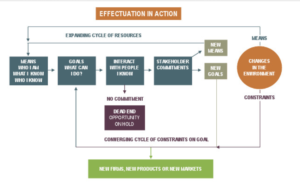The first step expert entrepreneurs take is to identify the means available to them. I illustrated this in the post Stop Looking At What You Don’t Have – Start With What You Do Have!
Then in the last post, I shared with you my story to illustrate the rest of the Effectuation Cycle.
In this post I want to discuss in more detail the second step of the cycle (i.e. Goals) which revolves around the question “What Can I Do?” This question focuses on what is do-able.

In my view though, this question lacks the perspective of differentiating myself from the competition. So I modified the question to “What Can I Do That Others Cannot?”
Below are 2 unique value proposition examples. But let’s worry about differentiation later.
For now, let’s just focus on “What Can I Do?”
Let me give you a couple of examples of answers to this question based on my story…
- I offer client management software (what I do) to financial services professionals (my target market/audience) to help them save time and deliver high quality service (benefits to my target audience).
- I make the powerful ideas of Systems Thinking easy to understand and practical (what I do) for decision makers (my target market/audience) so they can create better results for the work and for their lives (benefits to my target audience).
Notice a couple of things.
First, the answers depend on the means available to me (Step 1 of the cycle). So I had software writing skills and a good knowledge of the subject of Systems Thinking.
Second, I expanded on “What I Can Do?” by also answering the questions “Who is my target audience?” and “What is the benefit to my target audience?”
Features vs Benefits
It’s important to understand the difference between a benefit and the features of a product or service. People buy a service or product not for its features but for what the features can do for them (i.e. the benefits).
So making Systems Thinking easy to understand and practical is a feature of my service but not the benefit. The benefit is that my audience can create better results in their work and lives.
Here are a few features-benefits examples.
Example 1:
Feature – Bigger computer memory
Benefit – Get work done faster
Example 2:
Feature – Higher screen resolution
Benefit – Clearer Pictures; Less Eye Strain
Example 3:
Feature – Teflon coated pan
Benefit – Easier to clean
Maybe you can take a moment now to think about the answer to the question “What Can I Do?” Don’t forget to refer to the means available to you (Step 1).
Then include the 3 parts in your answer:
- What you can do (remember your strengths, interests, passion, knowledge, skills etc.).
- Your target audience.
- Benefits to your target audience (from their perspective).
If you have done that great. Don’t worry too much about getting it perfect at the start. As you move through the Effectuation Cycle, your answer will become clearer and crisper.
Differentiation – The Uniqueness Of Your Offering
Now we come to the differentiation portion of this post. This is important if you want to stand out from your competition and maximise your success.
The success of your business is simply based on the laws of supply and demand. Ideally, you want a great demand for your product or service, but little competition to supply it. This is a sweet and profitable spot for your business.
Big demand will not be very useful if you have a lot of competition. I sometimes hear the phrase “Everyone’s got to eat!” as justification for the opening of a new food and beverage outlet and expecting it to be profitable. That may be if you are in only outlet around. But many such outlets go out of business when there is intense competition.
But if you find an area with little or no competition, but has no customers – you will not succeed either. The good news is that if you are able to reach out to the entire world online, you can still find sufficient customers for your unique offering.
So now we have to answer the question “What Can I Do That Others Cannot?”
You need to check out the competition if any. I have seen so many people starting a business without doing this and end up closing down. You need to know what your potential competitors are offering for the problem you are trying to solve. If no one is offering a solution, then great! You have no competition. But If you find that many others are also offering what you plan to offer, you need to think more about how to differentiate yourself. You have to ask “What is a gap in their offering that I can plug?”
To help you here, please refer back to your previous answer and think of how you can differentiate yourself (if needed) by modifying any or all of the 3 components i.e.
- What you can do (remember your strengths, interests, passion, skills etc.)
- Your target audience.
- Benefits to your target audience (from their perspective).
In the case of Systems Thinking, what I did was to make it easy to understand and practical which very few people can do. How did I know this? I checked out the competition by reading as many books and as much material on the subject. I found most of them hard to understand and to apply. It was frustrating for me at first when I was trying to learn the subject. But frustrations often signal opportunity as well! Problems always presents an opportunity for profit.
But in the case of the client management software, I could not easily differentiate myself. So I chose not to pursue it further.
Let’s use this blog as another example of how to position a product or service. So…
I write a blog on (a) disruptive trends (b) strategies and tools to deal with these disruptions for professionals and freelancers to help them survive and prosper in turbulent times.
I write a blog on (a) disruptive trends (b) strategies and tools to deal with these disruptions for professionals and freelancers to help them survive and prosper in turbulent times.
Why do I think I can differentiate myself here? Well much of the material on disruptive trends tend to be written for CEO’s and Government policy makers. It does not help the professionals who may be disrupted out of their jobs. Although, there are a exceptions like the book The Gig Economy.
Then there is quite a bit of material focusing on tools to start online businesses. One popular book in this genre is Tim Ferriss’ book the 4-Hour Work Week. It’s a book I highly recommend if you have not read it yet. But it does not tie in with the larger underlying trends that are threatening to turn our world upside down. When you start a business, you need to be aware of these trends. Starting small business offering accounting services may be risky given the current trends. But offering a coaching service may be a more viable business.
So I am trying to fill a gap by linking the tools and strategies to the emerging global trends.
Bear in mind though that I do not do the original research on future trends. I rely on researchers for who publish their findings (e.g. in Harvard Business Review). The Effectuation strategy did not originate from me – it came from Saras Sarasvathy. And I may not be the best person to teach you how to build a website – but I can point you to one who can.
My role in this blog is not so much a content Creator but rather more an information Curator and in a sense a Coach. I pull various pieces of information together into a coherent whole to serve my target audience.
But how do I get income from writing a blog? This will be answered in upcoming posts when we look at various possible sources of online income.
Can I Have More Than One Offering?
Yes you can. Look at serial entrepreneurs like Richard Branson! He started a record company (Virgin Records), a mobile phone company (Virgin Mobile) and an airline (Virgin Atlantic).

You can do this by once again modifying any or all of the following components…
- What you can do (remember your strengths, interests, passion, skills etc.)
- Your target audience.
- Benefits to your target audience (from their perspective).
For example, I said that this blog was targeting professionals and freelancers.
But I can use the same information to target parents who want to know how to prepare their children for a digital and global economy. Or corporate leaders who want to keep abreast of what is going on and who want to create a culture of innovation in their organisations.
Japanese carmaker Toyota offers two brands of cars: (a) Toyota and (b) Lexus. Lexus is a luxury product catering to the higher end of the market.

Now when you answer the question “What Can I Do That Others Cannot?“, you are actually identifying your brand and niche. And like Toyota, you can have more than one brand or niche.
When you have more than one offering, it may be advisable to keep them distinct. Richard Branson had different offerings under different companies in different industries. So even when they were all under the Virgin label, the offerings were quite distinct. Toyota chose to distinguish their offering via different brand names.
But beware of offering too many things when you have limited capacity. The quality and brand of your offering may suffer as a result.
Conclusion
In completing the second step of the Effectuation Cycle, you have answered the question “What Can I Do That Others Cannot?”
You will have identified a niche and brand so to speak.
Again, the position of your offering can change as you interact with customers and other stakeholders.
Note that you can have more than one offering in which case it might be advisable to keep them distinct in the minds of your audience.
Also beware having too many offerings when you have limited capacity because this can erode the quality of your offering and brand.
So go and finish answering the question “What Can I Do That Others Cannot?” and I will see you in the next post!

